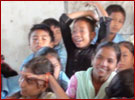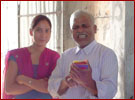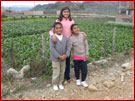|
Some statistics about education in Nepal
| Education |
Indicators |
| Youth (15-24 years) literacy rate, 2000-2006*, male |
81 |
| Youth (15-24 years) literacy rate, 2000-2006*, female |
60 |
| Number per 100 population 2005: phones |
3 |
| Number per 100 population 2005: Internet users |
1 |
| Primary school enrolment ratio 2000-2006*, gross, male |
129 |
| Primary school enrolment ratio 2000-2006*, gross, female |
123 |
| Primary school enrolment ratio 2000-2006*, net, male |
90 |
| Primary school enrolment ratio 2000-2006*, net, female |
83 |
| Primary school attendance ratio (2000-2006*) ratio, net, male |
86 |
| Primary school attendance ratio (2000-2006*) ratio, net, female |
82 |
| % of primary school entrants reaching grade 5 2000-2006*, admin.
data |
79 |
| % of primary school entrants reaching grade 5 2000-2006*, survey
data |
95 |
| Secondary school enrolment ratio 2000-2006*, gross, male |
46 |
| Secondary school enrolment ratio 2000-2006*, gross, female |
40 |
| Secondary school enrolment ratio 2000-2006*, net, male |
- |
| Secondary school enrolment ratio 2000-2006*, net, female |
- |
| Secondary school attendance ratio (2000-2006*), net, male |
46 |
| Secondary school attendance ratio (2000-2006*), net, female |
38 |
Definitions of the indicators
Adult literacy rate - Percentage of persons aged 15 and over who can read
and write.
Gross primary or secondary school enrolment ratio - The number of children
enrolled in a level (primary or secondary), regardless of age, divided
by the population of the age group that officially corresponds to the
same level.
Net primary school enrolment ratio - The number of children enrolled in
primary school who belong to the age group that officially corresponds
to primary schooling, divided by the total population of the same age
group.
Net primary school attendance - Percentage of children in the age group
that officially corresponds to primary schooling who attend primary school.
These data come from national household surveys.
Primary school entrants reaching grade five - Percentage of the children
entering the first grade of primary school who eventually reach grade
five.
Main data sources
Adult literacy - United Nations Educational, Scientific and Cultural Organization
(UNESCO), including the Education for All 2000 Assessment.
Phone and Internet use - International Telecommunications Union, Yearbook
of Statistics 1992-2001.
Primary and secondary school enrolment - UNESCO, including the Education
for All 2000 Assessment.
Net primary school attendance - Demographic and Health Surveys (DHS)
and Multiple Indicator Cluster Surveys (MICS).
Reaching grade five - Admin data: UNESCO Institute for Statistics, including
the Education for All 2000 Assessment. Survey data: DHS and MICS.
Notes
- Data not available.
x Indicates data that refer to years or periods other than those specified
in the column heading, differ from the standard definition, or refer to
only part of a country.
y Indicates data that differ from the standard definition or refer to
only part of a country, but are included in the calculation of regional
and global averages.
* Data refer to the most recent year available during the period specified
in the column heading.
We have used figures provided by UNICEF from their website
http://www.unicef.org/infobycountry/nepal_nepal_statistics.html
|





